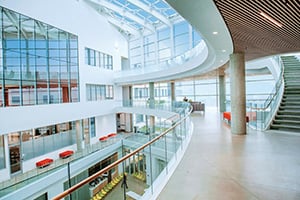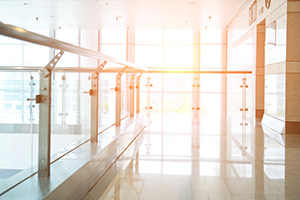 These days, environmental consciousness is at the forefront. Industries everywhere are innovating and creating ways to go green, and the retrofit lighting industry is no different.
These days, environmental consciousness is at the forefront. Industries everywhere are innovating and creating ways to go green, and the retrofit lighting industry is no different.
As the world turns its gaze toward greener practices, retrofit businesses are playing a pivotal role in helping their clients adopt sustainable lighting solutions. The more your business understands about it, the better positioned you are to guide them through the green revolution.
Below, we will dive into the world of sustainable lighting and cover the many benefits it offers.
Understanding Sustainable Lighting
Sustainable lighting is a design approach aimed at creating luminaires that generate minimal waste, consume less energy, and reduce carbon footprints. It’s one of the many sustainability trends customers are coming to expect. Nielsen IQ research suggests 78% of U.S consumers prioritize sustainability in their lifestyles and in the products they buy.
When you think of sustainable lighting, you probably think of classic LED bulbs, long praised for their energy efficiency. In recent years, they’ve become the standard in eco-friendly lighting, sometimes easier to find than their less-green counterparts.
But smart LEDs are a newer addition to the LED menu. They offer even more eco-friendly features and with a high-tech twist. These LEDs instantly adapt to environmental cues, optimizing energy consumption without the need for human oversight. That means no worrying if you leave the office lights on after work or forget to brighten a dimmer switch during an important client meeting.
LEDs: Environmental and Economic Benefits
How LEDs Light the Way to a Greener Future
- Incandescent light bulbs can waste up to 80% of the energy they consume as heat rather than light.
- 5% of global CO2 emissions are caused by lighting.
- LED Lights can last up to 25% longer than halogen light bulbs.
- LED lighting can reduce CO2 emissions by up to 1,400 million tons globally.
Sustainable lighting products aren’t just important to consumers. Companies are also looking to incorporate them into new buildings and redesigned office spaces because they offer incredible cost savings.
- LEDs boast a lifespan of up to 20 times longer than traditional lighting, resulting in significantly reduced waste.
- LEDs use less energy than other types of lighting, which translates to a reduced carbon footprint.
- The lower energy consumption of LEDs compared to conventional options also lowers maintenance costs, as they don't need frequent replacements.
- LEDs also reduce energy bills, which can compound in large corporate office buildings.
But sustainability also has to take disposal into account. If something lasts a long time but is a danger to the environment when it ends up in a landfill, it’s not really sustainable.
Luckily, LEDs check this box as well. Unlike Compact Fluorescent Lamps (CFLs), which pose disposal challenges due to high levels of toxic chemicals, LEDs can be disposed of just like paper or other normal office waste. This makes them an environmentally responsible choice for organizations who want to minimize their ecological impact during retrofit projects.
Improving the Sustainability of Your Lighting Retrofit
When you replace outdated and inefficient lighting with LEDs for your organization, you make huge strides in reducing daily energy consumption. You also decrease your carbon footprint and energy and maintenance costs, a big win for you and your company. LED lighting, with its energy efficiency, minimal waste production, and low maintenance requirements, aligns seamlessly with the goals of any successful retrofit project.
Additional Lighting Sustainability Trends
Beyond LED technology, there are additional strategies and technologies to enhance the sustainability of lighting retrofits.
 Daylighting strategies. Daylighting is designing an area to maximize natural light and reduce the need for electric lighting. Incorporating a variety of design elements and strategies, it can cut daytime electricity costs by 13%.
Daylighting strategies. Daylighting is designing an area to maximize natural light and reduce the need for electric lighting. Incorporating a variety of design elements and strategies, it can cut daytime electricity costs by 13%.
(Image source: Architect Magazine)
 Maximizing natural light: Though this is similar to daylighting, it doesn’t have to happen at the design stages of a building. It could be as simple as opening blinds during the day or moving a meeting to a room with a larger window when the sun is bright.
Maximizing natural light: Though this is similar to daylighting, it doesn’t have to happen at the design stages of a building. It could be as simple as opening blinds during the day or moving a meeting to a room with a larger window when the sun is bright.

Incorporating daylight harvesting systems: Think of this as maximizing natural light with an AI boost. Daylight harvesting systems use a photosensor to detect light levels in an area and adjust electric lighting based on the available daylight in a space.

Using natural illumination: Like daylighting, this strategy incorporates windows, skylights, and light tubes to maximize natural illumination and reduce the need for electric light.
Government Incentives and Rebates
Because of the energy efficiency of LED lights, government agencies have created incentives and rebates to encourage their use. That makes it easier — and more financially viable — to use sustainable lighting.
And that’s great news for end users and contractors, who can increase customer loyalty by alerting their clients to these cost-saving programs they may not otherwise know about.
Need help finding rebates for your next lighting project? Our rebate finder tool can help you find local and federal rebate programs that could help you go green for less.
As we’ve seen, the benefits of LED lighting go way deeper than sustainability. Embracing these solutions in retrofit projects is a simple way for your business or clients to get the peace of mind of knowing they’re contributing to a healthier planet while preserving a strong bottom line.

